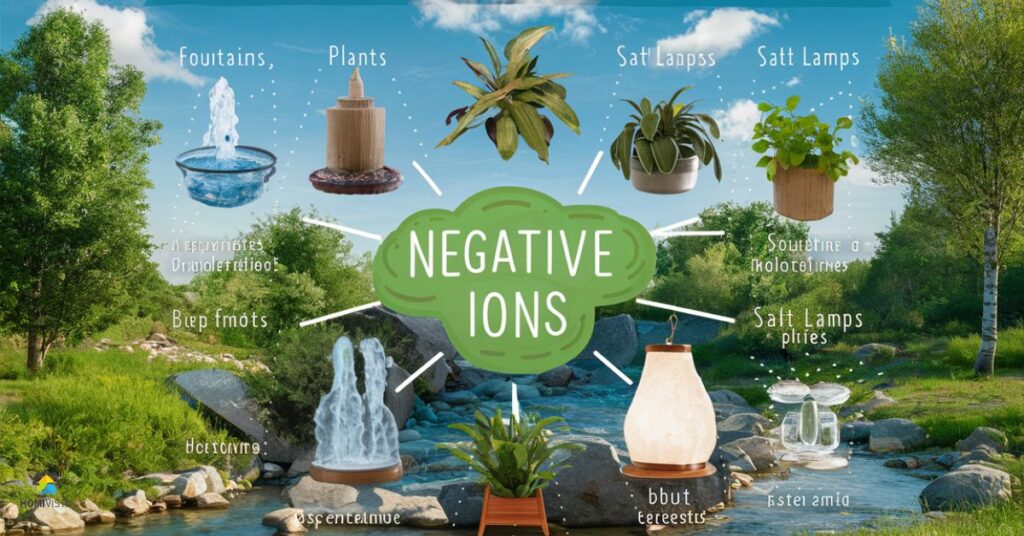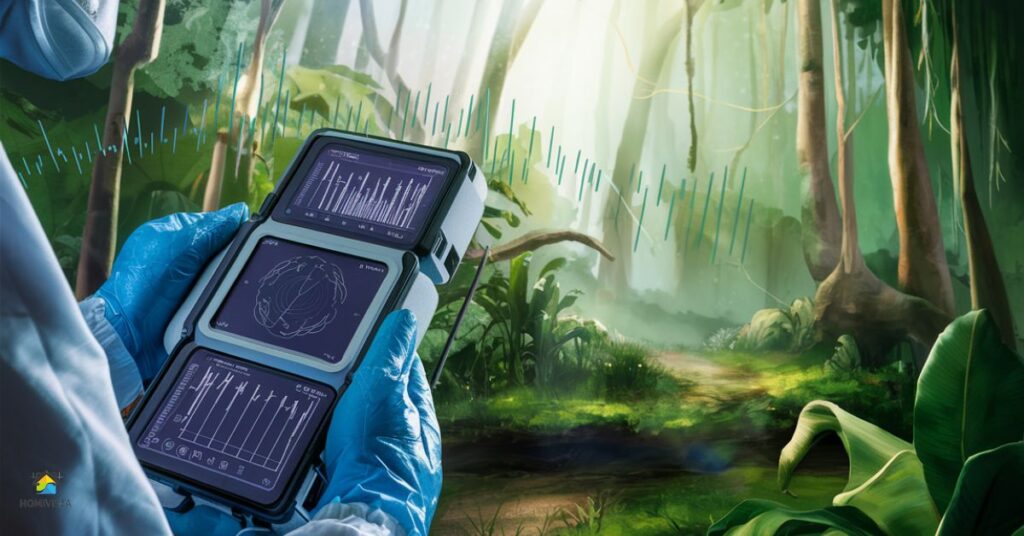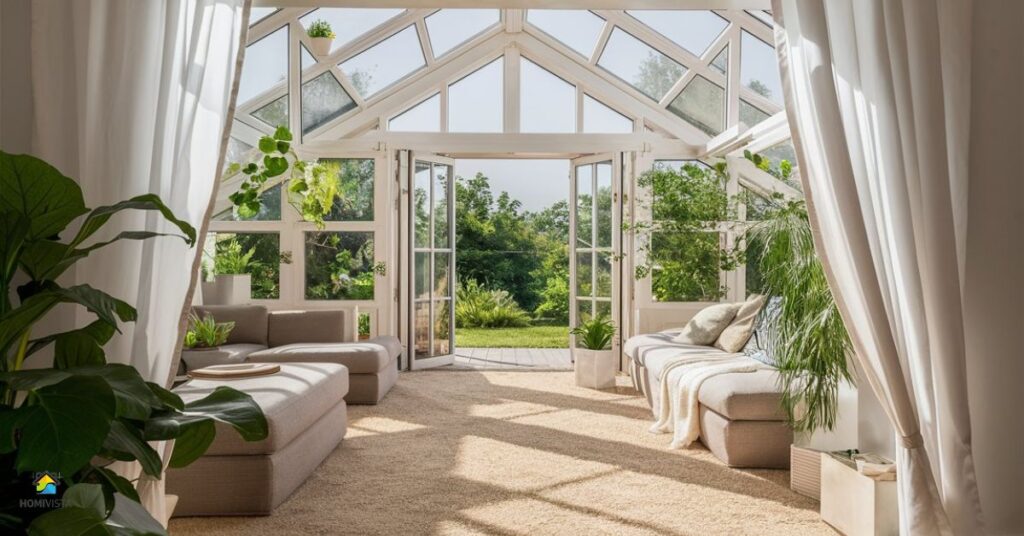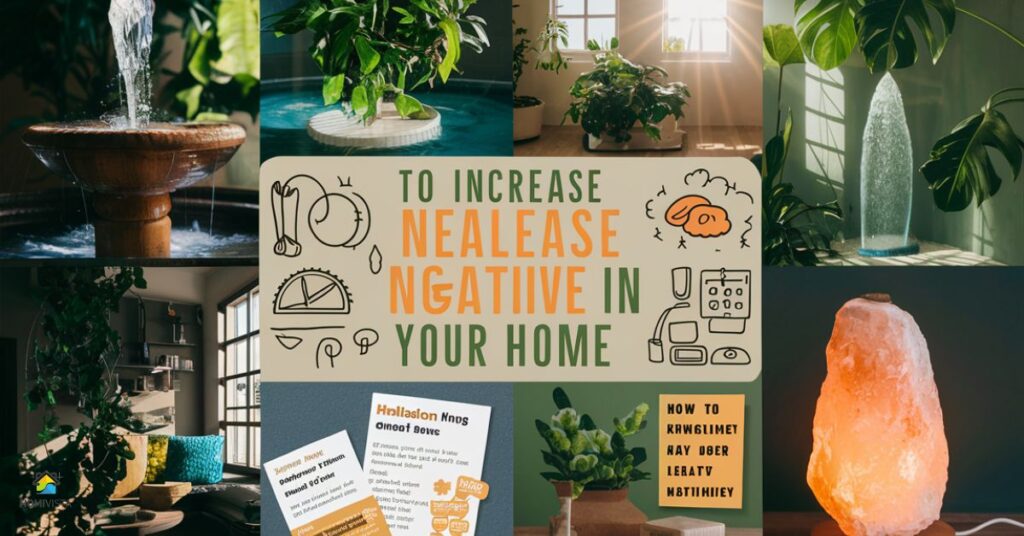Want a fresher, healthier home? Boosting negative ions can help. Negative ions, abundant in nature, improve air quality and mood. Easy ways to increase them indoors include using salt lamps, air purifiers, and indoor plants. Salt lamps emit negative ions naturally, while air purifiers filter out pollutants. Plants like peace lilies and spider plants also generate negative ions. Enhance your home’s atmosphere with these simple tips for a happier, cleaner environment.”
What are Negative Ions?
Negative ions are beneficial particles found in nature. They help purify the air by attaching to harmful particles and removing them. Negative ions can improve mood and overall well-being. Sources of negative ions include waterfalls, forests and lightning storms. They contribute to a fresher and healthier environment.
Make Your Own Negative ions
Creating negative ions at home is possible through simple methods. Water features like fountains or humidifiers release negative ions. Himalayan salt lamps emit ions when heated. Houseplants like spider plants and peace lilies generate negative ions. Regularly airing out rooms increases ion levels. These DIY approaches can enhance air quality and promote a more positive atmosphere indoors.
How to Increase Negative Ions in your Environment

- Open windows for fresh air circulation.
- Use air purifiers to remove pollutants.
- Incorporate houseplants for natural ion release.
- Consider Himalayan salt lamps for additional ions.
- Avoid synthetic fragrances that reduce negative ions.
- Minimize electronics and appliances that emit positive ions.
- Choose natural materials like wood and stone.
- Utilize water features like fountains or humidifiers.
- Opt for regular ventilation to maintain ion levels.
- These methods enhance air quality and promote well-being.
How does a negative ion form?
Negative ions form when molecules gain one or more extra electrons. This process occurs naturally in various environments. For example, sunlight can cause air molecules to split and create negative ions. Waterfalls generate negative ions through the friction of water droplets. Thunderstorms also produce negative ions due to electrical activity. These ions contribute to air freshness and can impact mood positively.
Read this blog: A Brief Overview Of Insulation Requirements In Florida
Where Are Negative Ions Found
Negative ions are abundant in natural settings such as forests, waterfalls and beaches. They are present near moving water sources like rivers and streams. Thunderstorms and lightning also produce negative ions. Indoor environments with houseplants and salt lamps can also have higher levels of negative ions. These ions contribute to air purity and overall well-being.
Create a Healthy Home with Negative Ions

Negative ions contribute to a healthy home environment in several ways. They help remove airborne pollutants, allergens and odors. Negative ions can enhance mood and mental clarity. Incorporating natural sources of negative ions, such as houseplants and salt lamps, can promote a fresher and more positive atmosphere indoors. These ions contribute to overall well-being and air quality.
Negative Ion Bracelets
Negative ion bracelets are accessories believed to provide health benefits. They emit negative ions that may improve mood and energy levels. The ions are typically generated by materials like tourmaline or volcanic rock within the bracelet. Some people wear these bracelets for potential stress relief and better well-being. However, scientific evidence supporting their effectiveness is limited.
What Generates Negative Ions?
Various natural phenomena and objects generate negative ions. Water sources like waterfalls and oceans produce ions through water movement. Thunderstorms and lightning create ions due to electrical activity. Certain minerals like tourmaline and amethyst also emit negative ions. Additionally, houseplants release negative ions, contributing to a healthier indoor environment. These sources collectively help maintain ion balance in nature.
How to measure negative ions?

Here are some methods to measure the negative ions:
Negative Ion Detector
A negative ion detector is a device that measures the concentration of negative ions in the air. It works by attracting negative ions to a sensor, which then detects and quantifies them. These detectors are used in various settings to assess air quality and ion levels. They provide valuable data for understanding the ion content in different environments.
Negative Ion Counter
A negative ion detector is a device that measures the concentration of negative ions in the air. It works by attracting negative ions to a sensor, which then detects and quantifies them. These detectors are used in various settings to assess air quality and ion levels. They provide valuable data for understanding the ion content in different environments.
Negative Ion Generator
A negative ion generator is a device designed to produce negative ions. It typically uses electricity to create an electric field that separates air molecules into positive and negative ions. These generators are used to enhance air quality by increasing negative ion levels indoors. They are often utilized in homes, offices and other enclosed spaces for their potential health benefits.
Negative Ion Concentration Meter
A negative ion concentration meter measures the number of negative ions present in the air. It employs sensors to detect and quantify the concentration of these ions accurately. This device is essential for assessing air quality and ion levels in various environments. It provides valuable data for understanding the ion content and overall freshness of the air.
Waterfalls From the Inside
Waterfalls from the inside offers a unique perspective. The cascading water creates a mesmerizing atmosphere. The sound of rushing water is soothing and immersive. You can feel the cool mist on your skin, refreshing and invigorating. The interior of waterfalls often has hidden caves and rock formations. It’s a thrilling experience to witness nature’s power up close.
Simple Steps to Inhale Positive Energy
- Start your day with deep breathing exercises.
- Spend time in nature, like parks or gardens.
- Practice mindfulness or meditation daily.
- Surround yourself with uplifting music or sounds.
- Engage in physical activities you enjoy.
- Declutter your living and workspaces regularly.
- Connect with positive and supportive people.
- Incorporate laughter and humor into your day.
- Practice gratitude by focusing on what you appreciate.
- Use positive affirmations to uplift your mindset daily.
Keep Your Home Ventilated

- Open windows regularly for fresh air circulation.
- Use exhaust fans in kitchens and bathrooms.
- Consider installing a ventilation system.
- Keep indoor plants for natural air purification.
- Use air purifiers to remove pollutants.
- Avoid smoking indoors to maintain air quality.
- Regularly clean air filters in HVAC systems.
- Use natural cleaning products to reduce toxins.
- Keep humidity levels balanced to prevent mold.
- Ventilate rooms after activities that produce fumes or odors.
Invest in Houseplants
Houseplants offer multiple benefits for your home environment. They purify the air by absorbing toxins. They add a touch of nature and beauty to indoor spaces. Certain plants can improve mood and reduce stress. Consider adding a variety of houseplants for a healthier and more vibrant living space.
Top Plants that Remove Toxins
Here are some plants that remove toxins:
Spider Plant: Removes formaldehyde and carbon monoxide.
Snake Plant: Filters benzene, formaldehyde, and trichloroethylene.
Peace Lily: Clears air of ammonia, benzene, and formaldehyde.
Boston Fern: Targets formaldehyde and xylene.
Aloe Vera: Eliminates benzene and formaldehyde.
Bamboo Palm: Removes formaldehyde, benzene, and trichloroethylene.
English Ivy: Filters airborne mold and formaldehyde.
Air Purifier with Negative Ion Generator
An air purifier with a negative ion generator cleans the air by removing pollutants. The negative ion generator boosts air quality by emitting negative ions. This combination enhances the purifying effects of the air purifier, creating a healthier indoor environment.
Benefits of negative ions
- Enhance mood and reduce stress.
- Improve air quality by removing pollutants.
- Boost energy levels and mental clarity.
- Support respiratory health by reducing allergens.
- Create a fresher and more invigorating environment.
- Aid in relaxation and promote better sleep quality.
- Counteract positive ions from electronic devices.
- Contribute to overall well-being and vitality.
Risks of negative ion exposure

Excessive negative ion exposure can lead to certain risks. Prolonged exposure may cause headaches or dizziness. Some individuals may experience respiratory irritation. High levels of negative ions in closed spaces can affect ion balance and air quality negatively.
Ozone particles
Increasing negative ions in your home can be beneficial, but it’s essential to do so safely without increasing ozone particles excessively. Here are some tips:
Choose the Right Products: Use negative ion generators or air purifiers specifically designed to emit negative ions without producing high levels of ozone.
Follow Manufacturer Guidelines: If using an ionizer or similar device, follow the manufacturer’s instructions carefully to avoid ozone buildup.
Use Natural Methods: Incorporate natural methods like houseplants, salt lamps or water features that generate negative ions without ozone production.
Monitor Air Quality: Regularly check indoor air quality to ensure that negative ion levels are increasing without a corresponding rise in ozone particles.
Ventilation: Ensure proper ventilation in your home to disperse any ozone particles that may be produced and maintain a healthy indoor environment.
Static electricity buildup
To decrease static electricity buildup and increase negative ions in your home, consider the following tips:
Use Houseplants: Certain houseplants like spider plants, peace lilies, and Boston ferns can release negative ions, reducing static electricity.
Natural Materials: Furnishings and decor made from natural materials like wood, stone, and cotton can help maintain ion balance and reduce static.
Salt Lamps: Himalayan salt lamps emit negative ions when heated, helping to neutralize static charges in the air.
Humidifiers: Using a humidifier can add moisture to the air, which can reduce static electricity buildup.
Avoid Synthetic Fabrics: Synthetic fabrics like polyester and nylon tend to generate more static electricity. Opt for natural fabrics whenever possible.
Grounding Mats: Consider using grounding mats or rugs made from natural materials to discharge static electricity from your body.
Respiratory irritation
Increasing negative ions in your home can have benefits but may also cause respiratory irritation in some individuals. Here’s how to manage it:
Choose Safe Methods: Use natural methods like houseplants or salt lamps that emit negative ions without causing respiratory irritation.
Avoid Overexposure: Limit the use of negative ion generators or air purifiers that may produce excessive amounts of negative ions, leading to respiratory discomfort.
Monitor Air Quality: Regularly check indoor air quality to ensure that negative ion levels are at a comfortable level and not causing respiratory issues.
Consult a Professional: If respiratory irritation persists, consult a healthcare professional or an indoor air quality expert for guidance and solutions.
Also Read: Who Pays For The Renovations On Instant Dream Home?
Negative ions vs. positive ions

Comparison between Negative ions and positive ions is as under:
| Aspect | Negative Ions | Positive Ions |
| Electrical Charge | Carry a negative electrical charge (-) | Carry a positive electrical charge (+) |
| Natural Sources | Waterfalls, forests, lightning storms | Electrical appliances, pollution, electronics |
| Effects on Mood | Generally associated with improved mood | Can contribute to feelings of stress |
| Air Purification | Bind to pollutants, remove from air | Can be involved in creating air pollutants |
| Health Benefits | Potential benefits for respiratory health | Can exacerbate respiratory issues |
| Presence in Nature | Abundant in natural outdoor environments | Commonly found indoors in urban settings |
| Impact on Air Quality | Can improve air quality by removing toxins | Can contribute to indoor air pollution |
Frequently asked questions
What are negative ions, and why are they important in the home environment?
Negative ions are molecules with an extra electron, known for their potential health benefits like improving air quality and mood. They are essential for creating a fresh and invigorating atmosphere indoors.
What natural methods can I use to increase negative ions in my home?
You can increase negative ions by incorporating houseplants, using salt lamps, opening windows for fresh air, and using water features like fountains or humidifiers.
Are negative ion generators safe to use at home?
Negative ion generators can be safe if used correctly and in moderation. It’s important to follow manufacturer guidelines and avoid excessive exposure to prevent any potential health risks.
How do negative ions improve air quality in the home?
Negative ions help remove airborne pollutants like dust, allergens, and odors by attaching to these particles and causing them to fall out of the air, thus enhancing air purity.
Can negative ions have any side effects on health?
While negative ions are generally beneficial, some individuals may experience mild respiratory irritation if exposed to very high levels. It’s essential to maintain a balanced ion level for optimal comfort.
How can I tell if there are enough negative ions in my home?
You can use air quality monitors or ion detectors to measure negative ion levels in your home. Additionally, paying attention to your mood, energy levels, and overall well-being can also indicate if negative ions are sufficient.
Are there any specific houseplants known for generating negative ions?
Yes, certain houseplants like spider plants, peace lilies, and bamboo palms are known for releasing negative ions and can be beneficial for indoor air quality.
Besides health benefits, are there any other advantages of increasing negative ions in the home?
Yes, besides health benefits, increasing negative ions can create a more relaxing, refreshing, and pleasant indoor environment, promoting overall comfort and well-being.
Conclusion
Increasing negative ions in your home is a simple yet effective way to promote a healthier and more invigorating environment. By incorporating natural methods like houseplants, salt lamps and ventilation, you can enhance air quality and create a fresher atmosphere indoors. It’s important to use negative ion generators safely and in moderation, following manufacturer guidelines to avoid any potential side effects.
Maintaining a balanced level of negative ions can lead to benefits such as improved mood, reduced stress and better overall well-being. Regularly monitoring indoor air quality and ensuring proper ventilation contribute to creating a comfortable and refreshing living space. Ultimately, by taking these steps, you can enjoy the positive effects of negative ions in your home for a healthier and happier lifestyle.

Meet Harry, our seasoned home decor specialist with three years of hands-on experience. His passion lies in crafting inviting spaces that reflect your style. From cozy corners to vibrant living rooms. Harry’s keen eye for design ensures every detail enhances the overall aesthetic. Trust him to turn your home into a personalized haven, blending functionality with flair.







